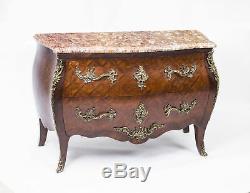
- Home
- Features
- 8-day (19)
- Aceo, Miniature (6)
- Antique (31)
- Boxed (9)
- Carvings (26)
- Decorative (19)
- Framed (32)
- Framed, Signed (7)
- Gilded (85)
- Gilded, Pair (93)
- Hand Painted (14)
- Limited Edition (8)
- One Of A Kind (ooak) (17)
- Ornate (20)
- Pair (151)
- Reclaimed (13)
- Roses Grapes (6)
- Salvage (49)
- Signed (17)
- Updated Wiring (8)
- ... (3410)
- Finish
- Item Height
- Item Length
- Shape
- Size
Antique French Louis Revival Parquetry Commode Chest Marble c. 1900



Regent Antiques has been trading in London for three decades. We specialise in English and Continental antique furniture, silver and porcelain. Our main markets are Europe and North America and we export worldwide. Antique French Louis Revival Parquetry Commode Chest Marble c. This is a stunning antique French Louis Revival bombe.
Commode, circa 1900 in date. It is crafted from the most beautiful. Has solid oak lined drawers, the most wonderful o. Marble top that has alluring hints of pink and yellow.
It has been beautifullyinlaid with elegant parquetry decoration, has two spacious drawers and the alluring contrast between the kingwood and the marble is offset by the most amazing gilded bronze ormolu handles and mounts. A truly gorgeous piece, this commode deserves pride of place in any furniture collection. Condition: In excellent condition having been beautifully restored in our workshops, please see photos for confirmation.Height 83 x Width 126 x Depth 58. Height 32.7 x Width 49.6 x Depth 22.8. Parquetry - is a geometric.
Pieces used for decorative effect. The two main uses of parquetry are as veneer patterns on furniture and block patterns for.
Parquet patterns are entirely geometrical and angular. The word derives from the Old French parchet (the diminutive of parc), literally meaning " a small enclosed space ".
Large diagonal squares known as parquet de. Were introduced in 1684 as parquet de menuiserie ("woodwork parquet") to replace the marble flooring that required constant washing, which tended to rot the joists beneath the floors. Such parquets en lozange were noted by the Swedish architect. At Versailles and at the. Timber contrasting in colour and grain such as oak, walnut, kingwood, rosewood, maple, etc.
Kingwood is a classic furniture wood, almost exclusively used for inlays on very fine furniture. Occasionally it is used in the solid for small items and turned work, including parts of billiard cues, e. Those made by John Parris. It is brownish-purple with many fine darker stripes and occasional irregular swirls. Occasionally it contains pale streaks of a similar colour to sapwood. The wood is very dense and hard and can be brought to a spectacular finish. It turns well but due to its density and hardness can be difficult to work with hand tools. It also has a tendency to blunt the tools due to its abrasive properties. Walnut The Walnut woods are probably the most recognisable and popular of all the exotic woods, having been used in furniture making for many centuries. Walnut veneer was highly priced and the cost would reflect the'fanciness' of the veneer - the more decorative, then the more expensive and desirable. Ormolu (from French'or moulu', signifying ground or pounded gold) is an 18th-century English term for applying finely ground, high-carat. The mercury is driven off in a. Leaving behind a gold-coloured veneer known as'gilt bronze'. The manufacture of true ormolu employs a process known as mercury-gilding or. In which a solution of.Is applied to a piece of. Or bronze, followed by the application of an. The item was then exposed to extreme heat until the mercury burned off and the gold remained, adhered to the metal object.
No true ormolu was produced in France after around 1830 because legislation had outlawed the use of mercury. Therefore, other techniques were used instead but nothing surpasses the original mercury-firing ormolu method for sheer beauty and richness of colour. Is the most common modern technique. Ormolu techniques are essentially the same as those used on.
Take a tour of our London showrooms. Take Piccadilly line to Manor House station. Go to top of escalators and turn left.
Take exit 7 and walk straight on for 10 metres. Manor Warehouse is on the right. There is car parking available on site. Please make all cheques payable to Regent Antiques. Bank details: Regent Antiques - BBVA - Account: 05701615 - Sort: 23-59-11.
For the best value, we recommend offsetting this cost by purchasing multiple items. The item "Antique French Louis Revival Parquetry Commode Chest Marble c. 1900" is in sale since Sunday, April 30, 2017. This item is in the category "Antiques\Antique Furniture\Chests of Drawers\Victorian (1837-1901)". The seller is "regentantiquesuk" and is located in London N4 1BX.
This item can be shipped worldwide.
